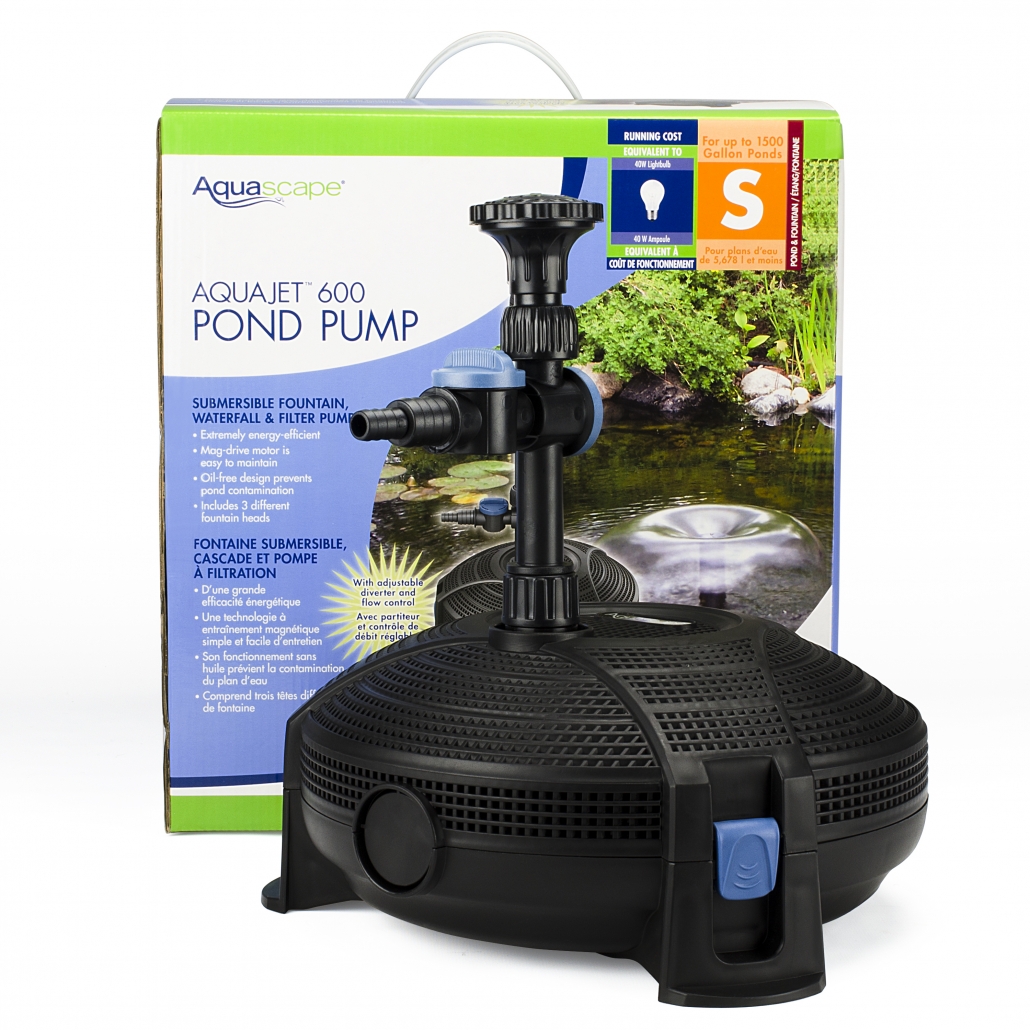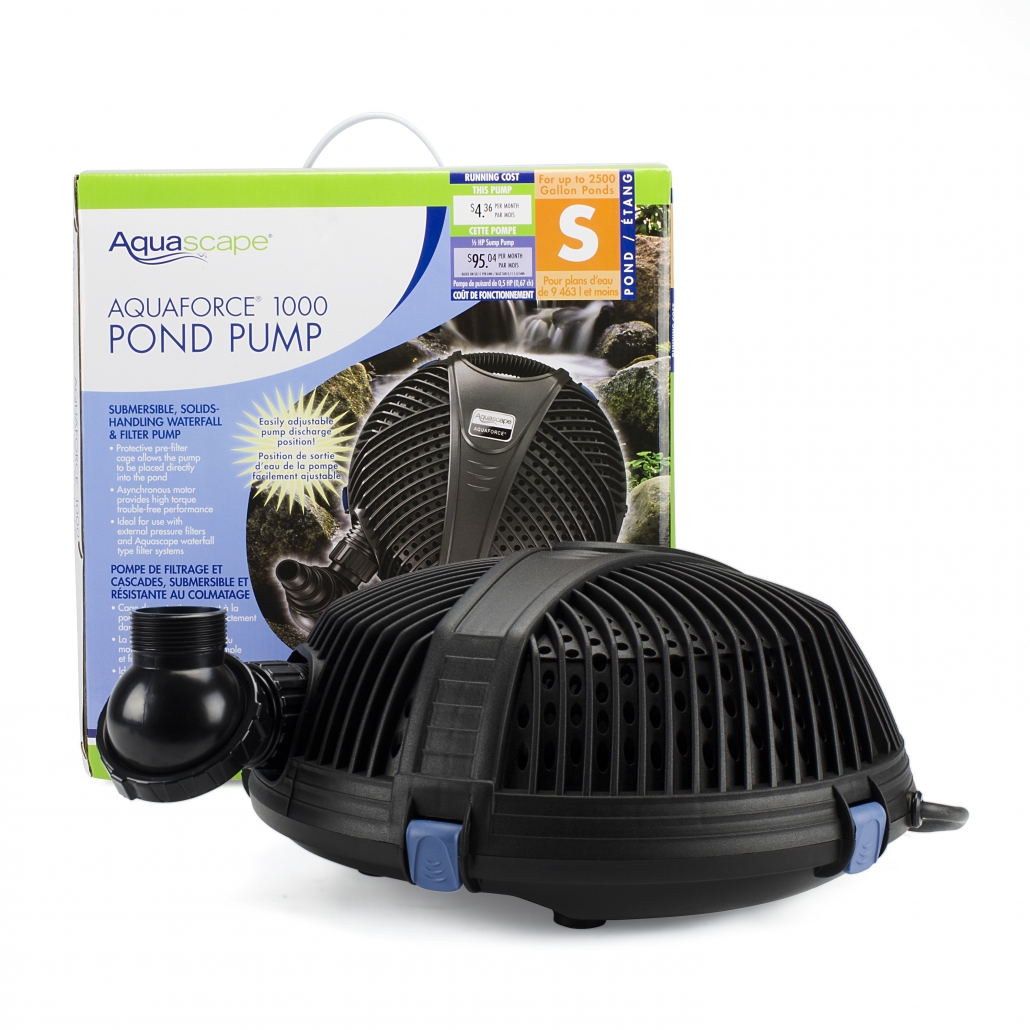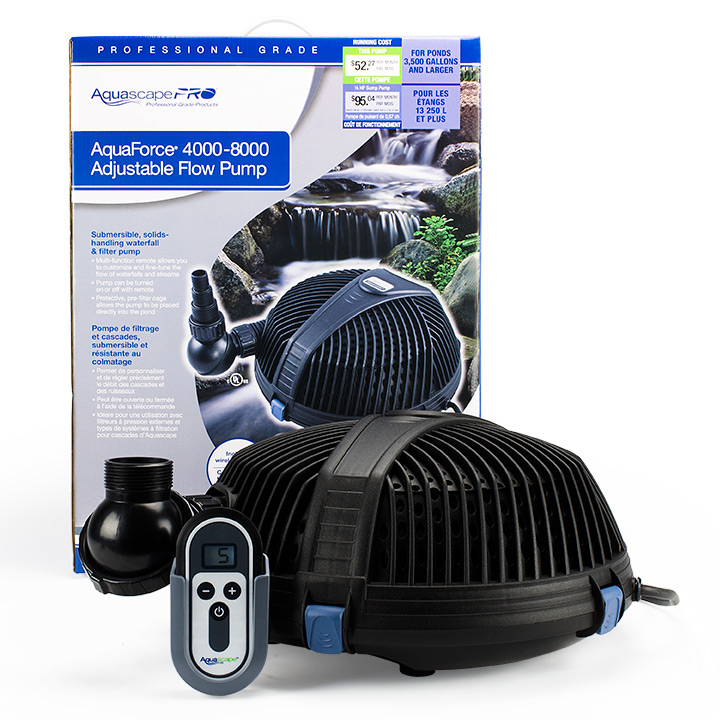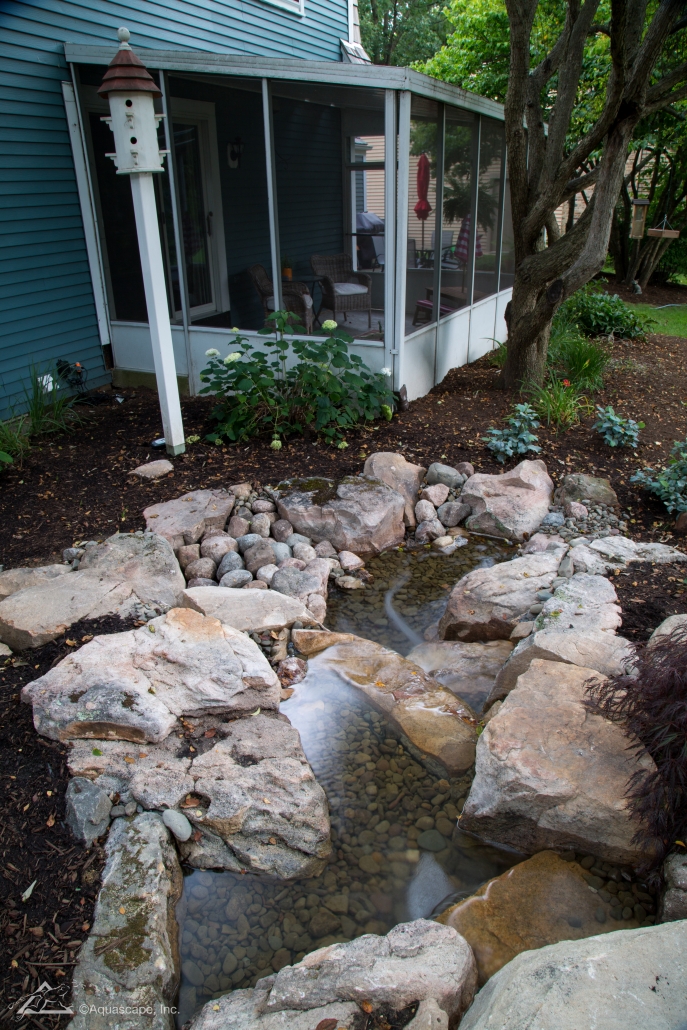How To Choose The Correct Pond Pump
Choosing a pump for your pond or fountain is a crucial step to ensure you maintain proper water movement. Failure to keep the water adequately circulated can result in stagnation, algae buildup, and mosquitoes. In addition, if you have fish, plants, or other aquatic life in your pond, you must keep the water healthy by evenly distributing the oxygen levels and other nutrients.

Types of Pond Water Pumps
There are two main types of pond water pumps: submersible and external (out-of-pond), also known as centrifugal pumps. Depending on the application, each pump offers specific advantages.

Submersible Pond Pumps
Submersible pumps are designed to be fully submerged underwater at the deepest part of the pond. They are placed directly into your pond or in a skimmer box or pond vault. Submersible pumps range in size from 50 to 5,000 gallons per hour. They are easy to install and are sometimes a more economical solution for smaller ponds (up to 1000 gallons of water). They are also quiet and can also be used to drain your pond. If you have fish or other aquatic life in your pond, you may want to consider a model that does not use oil because there is a danger of the pump seal breaking and oil coolant leaking into the water.

Centrifugal Pond Pumps
External or centrifugal pond pumps are a reliable, energy-efficient option. They are installed in a dry location near your pond. External pond water pumps are suitable for larger ponds (over 1000 gallons). Compared to a submersible pump, they are typically louder and more complicated to install; however, they are easier to maintain.
When selecting a pond pump, it’s essential to keep in mind that pumps have different cord lengths. Ensure the cord is long enough to go through the pond and plugin far away from the water. Some electrical codes specify that the outlet for water features must be at least 6 feet away from the water. Therefore, it is recommended that you avoid using an extension cord. However, if you must use one, make sure it’s suitable for outdoor use and plugged into a ground fault circuit interrupter (GFCI) so that it will immediately shut off if there is an overload.

How to Size a Fountain or Pond Pump
Pond pumps are sized by gallons per hour (GPH) at one foot of lift or height. Larger capacity pumps are rated by horsepower (HP). To determine the size pond pump, first, you need to calculate the volume of water in the pond. To calculate the volume of water in gallons, multiply the length x width x average depth x 7.5.

Water Circulation Factors
It is recommended that pond water is circulated at least once per hour. For example, if you have a 500-gallon pond, you need a pump that runs 500 gallons per hour at the discharge height. If your pond has a pressurized filter, you ideally want to turn the water approximately once every two hours. For example, if you have a 1000 gallon pond, you need a pond pump rated at a minimum of 500 GPH. If your pond has a skimmer or waterfall, the water should be turned approximately once every hour. Therefore, if you have an 1800 gallon pond, you will need an 1800 GPH rated pump.

Calculating Head and Lift Height
Two of the most critical measurements in sizing a pond or fountain pump are the maximum head height rating and maximum lift. Head height means the vertical height the pump raises water above the surface of the pond. The pond fountain pump’s top height can lift the water to is called “Maximum Head” or “Max Head.” The “Head” is measured straight up from the water level of the pond. Its length then measures any horizontal/diagonal flow, and 1′ of “Head” added per 10′ of horizontal/diagonal distance. To calculate the lift, you need to measure how far the water in your fountain has to travel from the pump’s location in your rush to the top of the fountain where the water comes out. Then you need to select a pump that lifts higher than that measurement. For example, if that distance is 24”, than you will need a fountain pump that lifts at least 36” tall. The “maximum lift” is the maximum height that the pump will raise the water.

Selecting the Proper Pond Water Pump Tubing
It is also essential to use the correct tubing size because it directly affects the pond pump‘s maximum lift capability. If you use smaller tubing than specified, you will limit the pump’s maximum lift and the amount of water circulated.
Choosing the right pond water pump for your pond or fountain requires careful consideration and a little upfront research. However, doing so will go a long way toward keeping your water clean and healthy and your pump operating efficiently.
Simple Steps to Monitor Pond Health Effortlessly
Keeping your pond healthy doesn’t have to be a complicated or time-consuming task. With the right tools and a regular routine, you can easily monitor your pond’s health and ensure that it remains a vibrant, balanced ecosystem. Whether you’re new to pond keeping or a seasoned enthusiast, these practical tips will help you maintain crystal-clear water and a thriving aquatic environment. 💧
Essential Parameters for Pond Health
A healthy pond is a dynamic system where water clarity, temperature, pH levels, and nutrient balances all play critical roles. Here are the key factors to keep an eye on:
- Water Clarity: Clear water is a good indicator of a balanced pond. Cloudiness or excessive algae growth can signal an imbalance.
- pH Levels: Most aquatic life thrives in a slightly acidic to neutral environment (around 6.5 to 7.5). Regular pH checks help prevent sudden shifts that could stress your pond inhabitants.
- Temperature: Water temperature affects dissolved oxygen levels and overall aquatic health. Monitoring temperature is particularly important during seasonal changes.
- Nutrient Levels: High levels of nutrients like nitrates and phosphates can lead to algae blooms. Keeping these in check is essential for preventing water quality issues.
Easy Tools for Monitoring
Modern technology has made it simpler than ever to keep tabs on your pond’s health. Here are a few user-friendly tools:
- Testing Kits: A comprehensive water testing kit can measure pH, ammonia, nitrites, nitrates, and other important parameters. These kits are available in both digital and manual formats.
- Digital Meters: Handheld digital meters provide quick and accurate readings of pH and dissolved oxygen levels, allowing for frequent, hassle-free monitoring.
- Smart Sensors: For those who prefer an automated approach, smart sensor systems continuously track water quality and send real-time updates to your smartphone. This is ideal for larger ponds or for anyone who wants to simplify the process.
- Thermometers: Submersible thermometers can help you keep a constant check on water temperature, ensuring your pond’s environment remains stable.
A Simple Routine for Regular Checks
Establishing a routine is key to easy pond maintenance. Here’s a straightforward monitoring schedule to consider:
- Daily Visual Inspection: A quick look at your pond each day can help you spot obvious issues like debris, excessive algae, or unusual water color.
- Weekly Testing: Use your testing kit or digital meters to check pH levels, clarity, and temperature once a week. Record your results to identify any trends or sudden changes.
- Monthly Deep Dive: Conduct a more comprehensive test of your water’s nutrient levels and other chemical parameters every month. This helps you catch potential problems before they escalate.
- Seasonal Reviews: As temperatures and weather conditions change, adjust your monitoring routine accordingly. Pay extra attention during the transition periods of spring and fall.
Benefits of Easy Monitoring
By keeping a regular eye on your pond’s health, you can:
- Prevent Problems: Early detection of imbalances allows you to make adjustments before issues become severe.
- Enhance Ecosystem Balance: Consistent monitoring supports a thriving environment for fish, plants, and beneficial bacteria.
- Reduce Maintenance Costs: Proactive care minimizes the need for costly treatments or extensive clean-ups.
- Enjoy Peace of Mind: Knowing your pond is healthy lets you relax and enjoy your outdoor space without constant worry.
Monitoring pond health doesn’t have to be daunting. With a few simple tools and a consistent routine, you can maintain a clean, balanced, and beautiful pond with minimal effort. Embrace these easy steps and let your pond flourish as a vibrant centerpiece of your outdoor sanctuary. 😊
Monitoring Water Garden Health
Maintaining a healthy water garden is key to enjoying its beauty year-round. By regularly monitoring water quality and the overall ecosystem, you ensure that your aquatic haven remains vibrant, clear, and supportive of plant and wildlife life. Here are some essential tips and strategies to help you monitor and maintain water garden health effectively. 💧
Understanding the Importance of Water Quality
Water quality directly influences the health of your water garden. Clean, well-oxygenated water supports aquatic plants, discourages algae overgrowth, and creates a balanced environment for fish and beneficial bacteria. Regular monitoring helps you catch issues early, ensuring that your garden stays pristine and inviting.
Key Parameters to Monitor
1. pH Levels:
The pH of your water is critical. Most aquatic plants and animals thrive in slightly acidic to neutral water (typically between 6.5 and 7.5). Regular testing with pH strips or digital meters can help you maintain a balanced environment. If your pH drifts too far in either direction, it may be necessary to add buffering agents to restore equilibrium.
2. Dissolved Oxygen:
Oxygen is the lifeblood of any aquatic system. Ensure that your water is well-oxygenated by monitoring dissolved oxygen levels. Adequate circulation from a quality pump not only helps maintain oxygen levels but also keeps the water moving to prevent stagnation.
3. Water Clarity:
Clear water is a sign of a healthy water garden. Cloudiness or discoloration often indicates algae growth or suspended particles. Regularly check for clarity by observing the water’s appearance and conducting tests if needed. Mechanical filters and natural aquatic plants can help manage water clarity.
4. Temperature:
Water temperature can significantly affect your garden’s ecosystem. Extreme temperatures may stress aquatic life. Use a waterproof thermometer to monitor temperatures, especially during seasonal changes, to ensure they remain within the ideal range for your plants and animals.
5. Nutrient Levels and Algae:
Nutrients like nitrates and phosphates feed algae. Over-fertilization or organic waste buildup can lead to algae blooms, which cloud your water and disrupt the ecosystem. Regular testing and, if necessary, using natural or chemical treatments can keep nutrient levels in check.
Tools and Techniques for Monitoring
- Testing Kits and Digital Meters: Invest in comprehensive water testing kits that cover pH, dissolved oxygen, and nutrient levels. Digital meters offer precision and ease of use.
- Regular Visual Inspections: Sometimes, a simple observation goes a long way. Look for signs of plant health, algae buildup, and clarity in your water garden.
- Automation and Smart Sensors: Modern technology has made monitoring easier than ever. Sensor-driven systems can continuously track water quality and send alerts to your smartphone, ensuring you stay informed about changes in real time.
- Professional Help: For larger water features, consider periodic evaluations by professionals who can provide a detailed analysis and recommend adjustments.
Establishing a Monitoring Routine
Creating a regular schedule for water testing and maintenance is vital. Daily or weekly checks can help you catch minor issues before they escalate. Document your findings over time—this data can reveal trends and help you make proactive adjustments to your water garden’s ecosystem.
Monitoring water garden health is an ongoing commitment that pays dividends in the form of clear water, thriving plants, and a balanced ecosystem. With the right tools, regular attention, and a proactive approach, you can enjoy an outdoor oasis that is as beautiful as it is sustainable. Embrace these practices, and let your water garden flourish into a living, breathing retreat that revitalizes your space and spirit. 😊
Water Feature Pumps: The Engine Behind Your Oasis
Water feature pumps are the unsung heroes of any thriving water garden, providing the essential circulation that brings your outdoor oasis to life. These powerful devices ensure that every drop of water is continuously recirculated, creating mesmerizing waterfalls, gentle streams, and tranquil ponds that enhance the natural beauty of your landscape. Whether you’re designing a compact garden fountain or a sprawling aquatic paradise, the right pump can transform your vision into a reality. 💦
The Heart of Your Water Feature
At the core of every successful water installation is reliable and efficient water movement. Water feature pumps work tirelessly to circulate water, maintaining clarity and preventing stagnation. They support the overall health of your aquatic ecosystem by delivering oxygen, controlling algae growth, and ensuring that every part of your water feature remains vibrant and inviting.
Energy Efficiency and Sustainability
In today’s eco-conscious world, energy efficiency is a critical factor in outdoor design. Modern water feature pumps are engineered to deliver robust performance while consuming minimal energy. By incorporating advanced technology and energy-saving features, these pumps reduce your overall power consumption and operating costs. Many models also include smart controls, allowing you to adjust the flow and cycle times based on real-time conditions. This not only makes your water feature more sustainable but also extends the lifespan of your pump system.
Versatility in Design
Water feature pumps come in a variety of sizes and power outputs, making them suitable for a range of applications—from delicate garden fountains to large-scale water installations. Their versatility allows you to customize your water display to suit your aesthetic and functional needs. For instance, variable flow settings enable you to create dynamic effects, such as a powerful cascade during the day that transitions to a gentle trickle in the evening. This level of control ensures that your water feature remains adaptable and responsive to your outdoor environment.
Ease of Installation and Maintenance
One of the greatest advantages of modern water feature pumps is their ease of installation and low maintenance requirements. Designed with user-friendly features, these pumps are straightforward to set up, even for those new to water feature design. Once installed, regular maintenance is minimal—often limited to routine cleaning and occasional system checks to ensure peak performance. This simplicity allows you to focus on enjoying your outdoor sanctuary rather than being bogged down by upkeep.
Enhancing the Aesthetic Appeal
Beyond their practical benefits, water feature pumps play a crucial role in the overall aesthetics of your water garden. The smooth, continuous movement of water creates a calming soundtrack and visual rhythm that can transform a simple garden into a dynamic retreat. Pairing a well-chosen pump with complementary lighting and landscaping can elevate your outdoor space, making it a perfect setting for both relaxation and entertainment.
Final Thoughts
Water feature pumps are more than just mechanical devices—they are the driving force behind the beauty and functionality of your outdoor water features. With advances in energy efficiency, versatility, and ease of maintenance, modern pumps offer a forward-thinking solution for creating sustainable, captivating water displays. Embrace the power of innovative pump technology to elevate your garden into a true oasis, where every ripple and cascade tells a story of nature in motion. 😊

 Meyer Aquascape
Meyer Aquascape
 Meyer Aquascapes
Meyer Aquascapes
